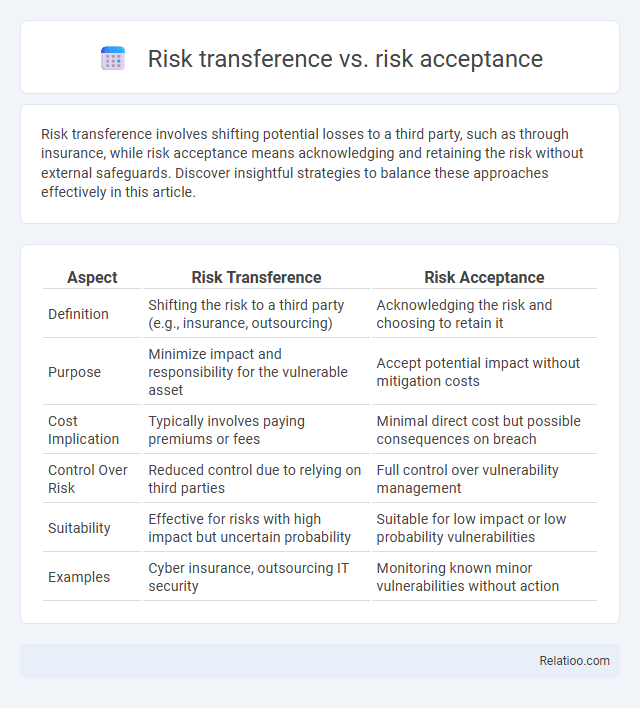Risk transference involves shifting potential losses to a third party, such as through insurance, while risk acceptance means acknowledging and retaining the risk without external safeguards. Discover insightful strategies to balance these approaches effectively in this article.
Table of Comparison
| Aspect | Risk Transference | Risk Acceptance |
|---|---|---|
| Definition | Shifting the risk to a third party (e.g., insurance, outsourcing) | Acknowledging the risk and choosing to retain it |
| Purpose | Minimize impact and responsibility for the vulnerable asset | Accept potential impact without mitigation costs |
| Cost Implication | Typically involves paying premiums or fees | Minimal direct cost but possible consequences on breach |
| Control Over Risk | Reduced control due to relying on third parties | Full control over vulnerability management |
| Suitability | Effective for risks with high impact but uncertain probability | Suitable for low impact or low probability vulnerabilities |
| Examples | Cyber insurance, outsourcing IT security | Monitoring known minor vulnerabilities without action |
Understanding Risk Transference and Risk Acceptance
Risk transference involves shifting potential loss from one party to another, often through insurance or outsourcing, reducing direct exposure to financial risk. Risk acceptance occurs when an organization consciously decides to bear the potential impact of a risk, usually when mitigation or transfer costs exceed the benefits. Understanding risk transference and risk acceptance is crucial for effective risk management strategies, ensuring that risks are either managed through third-party involvement or internal resources.
Key Differences Between Risk Transference and Risk Acceptance
Risk transference involves shifting the potential financial impact of a risk to a third party, commonly through insurance policies or contractual agreements, while risk acceptance means acknowledging the risk and choosing to bear its consequences without external support. The key difference lies in risk transference's proactive delegation of liability, which reduces exposure, whereas risk acceptance retains full responsibility and prepares for potential losses internally. Organizations employ risk transference to mitigate uncertainties financially, whereas risk acceptance is suitable when risks are minor or mitigation costs exceed potential impact.
When to Choose Risk Transference
Risk transference is an effective strategy when Your organization lacks the resources or expertise to manage a specific risk internally, making it preferable over risk acceptance, which involves acknowledging the risk without action. Choosing risk transference, such as through insurance or outsourcing, mitigates potential financial losses and shifts responsibility to a third party better equipped to handle the risk. This approach is ideal when the risk impact is high, but the probability of occurrence is moderate to low, ensuring that Your business continuity and assets remain protected.
Situations Favoring Risk Acceptance
Risk transference involves shifting potential loss to a third party, such as through insurance or outsourcing, while risk acceptance means consciously deciding to bear the risk without mitigation efforts. Situations favoring risk acceptance typically include low-impact risks with minimal financial consequences, highly unlikely events, or when mitigation costs surpass potential losses. Understanding your organization's risk tolerance and resource allocation is essential to determine when accepting risk is a strategic choice.
Benefits of Risk Transference in Business
Risk transference allocates potential financial losses to third parties, such as insurance companies, reducing direct exposure and stabilizing cash flow in business operations. This approach enhances risk management by allowing firms to focus resources on core activities while mitigating unforeseen liabilities. Compared to risk acceptance, transferring risk minimizes the impact of adverse events and supports long-term organizational resilience.
Advantages and Drawbacks of Risk Acceptance
Risk acceptance allows you to retain control over potential losses without incurring additional costs associated with risk transfer methods like insurance or outsourcing. This approach is advantageous in situations where the cost of transferring risk outweighs the potential impact of the loss or when risks are minor and manageable. However, the drawback lies in your exposure to potentially significant financial or operational impacts if risks materialize, requiring a strong contingency plan to mitigate adverse effects.
Common Examples of Risk Transference Strategies
Risk transference involves shifting potential losses to a third party, commonly seen in insurance policies such as property, liability, and health insurance. Risk acceptance occurs when you acknowledge potential risks without taking active measures, often for low-impact or cost-prohibitive scenarios. Common risk transference strategies include outsourcing specific operations, purchasing comprehensive insurance coverage, and entering contractual agreements with indemnity clauses to protect your business from financial exposure.
Effective Risk Acceptance Practices
Effective risk acceptance practices involve identifying risks that fall within an organization's tolerance and consciously choosing to retain them rather than transfer or mitigate. Risk transference shifts the potential impact of a risk to a third party, commonly through insurance or outsourcing, while risk acceptance acknowledges the risk as manageable without intervention. Prioritizing thorough risk assessment, clear communication, and continuous monitoring ensures that accepted risks do not exceed strategic thresholds and supports informed decision-making aligned with organizational goals.
Impact on Organizational Risk Management
Risk transference shifts potential losses to third parties, such as insurers, reducing Your organization's direct exposure and financial impact. Risk acceptance involves consciously retaining known risks when the cost of mitigation outweighs the potential damage, requiring robust internal controls to manage impact. Balancing transference and acceptance enhances organizational risk management by optimizing resource allocation and maintaining operational resilience.
Decision-Making Factors: Transference vs. Acceptance
Risk transference involves shifting potential losses to a third party, such as through insurance, while risk acceptance means deliberately choosing to bear the risk without mitigation. Your decision-making factors should weigh the cost of transferring risk, the likelihood and impact of the risk itself, and your organization's risk tolerance levels. Evaluating financial capacity, potential consequences, and control over risk outcomes helps determine whether transference or acceptance is the optimal strategy.

Infographic: Risk transference vs risk acceptance
 relatioo.com
relatioo.com